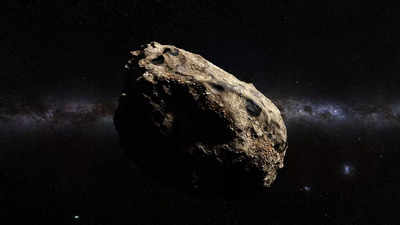- News
- Science News
- Nasa's new frontier: Hubble telescope to probe secrets of small asteroids
Nasa's new frontier: Hubble telescope to probe secrets of small asteroids
Nasa's Hubble Space Telescope collaborates with ESA on a mission targeting small main belt asteroids to deepen understanding of early solar system mysteries. Managed by Nasa's Goddard Center and Lockheed Martin, the mission explores asteroid composition, dynamics, and impact risks.

Representative image
Nasa's Hubble Space Telescope, in collaboration with the European Space Agency (ESA), has initiated a novel mission targeting small asteroids within the main belt. This effort seeks to deepen our understanding of these celestial objects, which are considered crucial to unraveling the mysteries of the early solar system. Managed by Nasa's Goddard Space Flight Center and supported by Lockheed Martin Space for mission operations, the telescope continues its over three-decade-long legacy of space exploration and discovery.
The new focus on small main belt asteroids aims to provide insights into their composition and dynamics, aspects that remain underexplored compared to their larger counterparts. Researchers from the Space Telescope Science Institute in Baltimore, Maryland, are leading the science operations. This institute, a hub for astronomical research, operates under the Association of Universities for Research in Astronomy and is integral to the success of Hubble's missions.
Understanding the properties of these small asteroids could shed light on the processes that shaped the terrestrial planets, including Earth. Moreover, this mission could also enhance our knowledge of asteroid impact risks and contribute to planetary defense strategies. By extending its gaze to these smaller bodies, Hubble is set to fill significant gaps in our astronomical knowledge and potentially pave the way for future explorations.
The Hubble Space Telescope (HST) has been instrumental in numerous significant astronomical discoveries since its launch in 1990. Some of its most notable contributions include:
Age of the Universe: Hubble's measurements of Cepheid variables—stars used as cosmic yardsticks—helped refine calculations of the universe's age. Current estimates put the age at about 13.8 billion years, which is much more accurate compared to pre-Hubble estimations.
Discovery of Dark Energy: Linked to the universe's expansion, Hubble's observations provided strong evidence for the presence of dark energy, a mysterious force driving the acceleration of the universe’s expansion.
Exoplanets: Hubble has been used to observe the atmospheres of exoplanets (planets outside our solar system) directly. It was able to detect the presence of water vapor, sodium, and even organic molecules in some exoplanetary atmospheres, providing insights into their composition and conditions.
The new focus on small main belt asteroids aims to provide insights into their composition and dynamics, aspects that remain underexplored compared to their larger counterparts. Researchers from the Space Telescope Science Institute in Baltimore, Maryland, are leading the science operations. This institute, a hub for astronomical research, operates under the Association of Universities for Research in Astronomy and is integral to the success of Hubble's missions.
Understanding the properties of these small asteroids could shed light on the processes that shaped the terrestrial planets, including Earth. Moreover, this mission could also enhance our knowledge of asteroid impact risks and contribute to planetary defense strategies. By extending its gaze to these smaller bodies, Hubble is set to fill significant gaps in our astronomical knowledge and potentially pave the way for future explorations.
The Hubble Space Telescope (HST) has been instrumental in numerous significant astronomical discoveries since its launch in 1990. Some of its most notable contributions include:
Expansion of the Universe: Hubble played a critical role in determining the rate of expansion of the universe. Through observations of distant supernovae, astronomers using Hubble data concluded that the universe is not only expanding but doing so at an accelerating rate, leading to the concept of dark energy.
Age of the Universe: Hubble's measurements of Cepheid variables—stars used as cosmic yardsticks—helped refine calculations of the universe's age. Current estimates put the age at about 13.8 billion years, which is much more accurate compared to pre-Hubble estimations.
Discovery of Dark Energy: Linked to the universe's expansion, Hubble's observations provided strong evidence for the presence of dark energy, a mysterious force driving the acceleration of the universe’s expansion.
Exoplanets: Hubble has been used to observe the atmospheres of exoplanets (planets outside our solar system) directly. It was able to detect the presence of water vapor, sodium, and even organic molecules in some exoplanetary atmospheres, providing insights into their composition and conditions.
End of Article
FOLLOW US ON SOCIAL MEDIA

